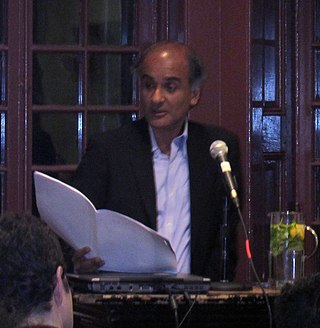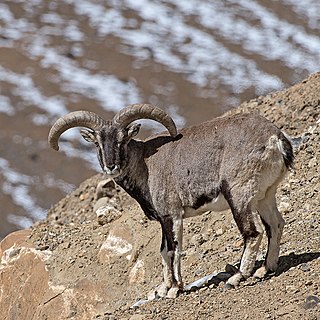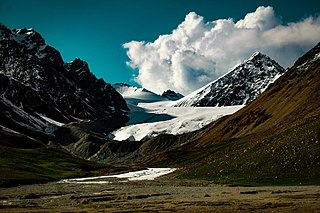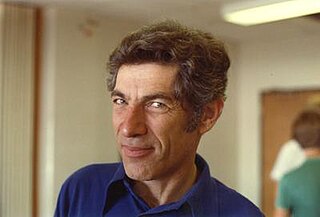
Barbara Wertheim Tuchman was an American historian, journalist and author. She won the Pulitzer Prize twice, for The Guns of August (1962), a best-selling history of the prelude to and the first month of World War I, and Stilwell and the American Experience in China (1971), a biography of General Joseph Stilwell.

Siddharth Pico Raghavan Iyer, known as Pico Iyer, is a British-born essayist and novelist known chiefly for his [writing on explorations both inner and outer ]. He is the author of numerous books on crossing cultures including Video Night in Kathmandu, The Lady and the Monk and The Global Soul. He has been a constant contributor to Time,Harper's, The New York Review of Books, and The New York Times, among a huge selection of other periodicals
Richard Thomas Mabey is a writer and broadcaster, chiefly on the relations between nature and culture.

The bharal, also called the blue sheep, is a caprine native to the high Himalayas. It is the only member of the genus Pseudois. It occurs in India, Bhutan, China, Myanmar, Nepal, and Pakistan. The Helan Mountains of Ningxia have the highest concentration of bharal in the world, with 15 bharals per km2 and 30,000 in total.

Peter Matthiessen was an American novelist, naturalist, wilderness writer, zen teacher and onetime CIA agent. A co-founder of the literary magazine The Paris Review, he is the only writer to have won the National Book Award in both nonfiction and fiction. He was also a prominent environmental activist.

Khenpo Tsültrim Gyamtso Rinpoche was a Tibetan scholar yogi in the Kagyu tradition of Tibetan Buddhism. He taught widely in the West, often through songs of realization, his own as well as those composed by Milarepa and other masters of the past. "Tsültrim Gyamtso" translates to English as "Ocean of Ethical Conduct". He died on 22 June 2024, at the age of 90.

Dolpo is a high-altitude culturally Tibetan region in the upper part of the Dolpa District of western Nepal, bordered in the north by China. Part of the region lies in Shey Phoksundo National Park. The sparse, agro-pastoral population, known as Dolpo or Dolpopa in standard Tibetan and Dhol-wa in the local dialect, is connected to the rest of Nepal via Jufal airport, which can be reached in three days by horse. As the 2011 census, the population of Dolpo is estimated to be 36,700 with the majority of these people following Buddhism as their major religion.

Hemis National Park is a high-elevation national park in Hemis in Leh district of Ladakh, India. It is approx. 50 km from Leh, the capital of Ladakh. Globally famous for its snow leopards, it is believed to have the highest density of them in any protected area in the world. It is the only national park in India that is north of the Himalayas, the largest notified protected area in India and is the second largest contiguous protected area, after the Nanda Devi Biosphere Reserve and surrounding protected areas. The park is home to a number of species of endangered mammals, including the snow leopard. Hemis National Park is India's protected area inside the Palearctic realm, outside the Changthang Wildlife Sanctuary northeast of Hemis, and the proposed Tso Lhamo Cold Desert Conservation Area in North Sikkim.

Khunjerab National Park is a national park in Gilgit Baltistan, Pakistan. Khunjerab National Park is Pakistan's third largest national park, and is adjacent to the Taxkorgan Natural Reserve in China.

Reuben Hersh was an American mathematician and academic, best known for his writings on the nature, practice, and social impact of mathematics. Although he was generally known as Reuben Hersh, late in life he sometimes used the name Reuben Laznovsky in recognition of his father's ancestral family name. His work challenges and complements mainstream philosophy of mathematics.
Shey Phoksundo National Park is the largest and only trans-Himalayan national park in Nepal. It was established in 1984 and covers an area of 3,555 km2 (1,373 sq mi) in the districts of Dolpa and Mugu in the Mid-Western Region, Nepal. The protected area ranges in elevation from 2,130 to 6,885 m. Phoksundo Lake is the park's prominent feature, located at an elevation of 3,612 m (11,850 ft).

The snow leopard, occasionally called ounce, is a species of large cat in the genus Panthera of the family Felidae. The species is native to the mountain ranges of Central and South Asia. It is listed as Vulnerable on the IUCN Red List because the global population is estimated to number fewer than 10,000 mature individuals and is expected to decline about 10% by 2040. It is mainly threatened by poaching and habitat destruction following infrastructural developments. It inhabits alpine and subalpine zones at elevations of 3,000–4,500 m (9,800–14,800 ft), ranging from eastern Afghanistan, the Himalayas and the Tibetan Plateau to southern Siberia, Mongolia and western China. In the northern part of its range, it also lives at lower elevations.
Floyd Skloot is an American poet, novelist, and memoirist. Some of his work concerns his experience with neurological damage caused by a virus contracted in 1988.

George Beals Schaller is an American mammalogist, biologist, conservationist and author. Schaller is recognized by many as the world's preeminent field biologist, studying wildlife throughout Africa, Asia and South America. Born in Berlin, Schaller grew up in Germany, but moved to Missouri as a teen. He is vice president of Panthera Corporation and serves as chairman of their Cat Advisory Council. Schaller is also a senior conservationist at the Bronx Zoo-based Wildlife Conservation Society.
The National Book Award for Nonfiction is one of five U.S. annual National Book Awards, which are given by the National Book Foundation to recognize outstanding literary work by U.S. citizens. They are awards "by writers to writers". The panelists are five "writers who are known to be doing great work in their genre or field".

Sy Montgomery is an American naturalist, author, and scriptwriter who writes for children as well as adults.
Chang Tang National Nature Reserve lies in the northern Tibetan Plateau. It is the third-largest land nature reserve in the world, after the Northeast Greenland National Park and Kavango-Zambezi Transfrontier Conservation Area, with an area of over 334,000 km2 (129,000 sq mi), making it bigger than 183 countries. Administratively, it lies in Xainza County and Biru County of the Nagqu Prefecture. With the more recently established adjoining reserves listed below there is now a total of 496,000 km2 of connected Nature Reserves, which represents an area almost as large as Spain and bigger than 197 other countries.

The Taxkorgan Nature Reserve is a nature reserve in Kashgar Prefecture, Xinjiang, China. It is situated around the Taghdumbash Pamir of Pamir Mountains and Karakorum Mountains. It covers about 14,000 square kilometres (5,400 sq mi) was established in 1984 mainly to protect the rare Marco Polo sheep and Tibetan argali. It has since also served to protect other species such as the snow leopard.

Karna Shakya is a Nepalese environmentalist, conservationist, hotel entrepreneur, writer and philanthropist. Shakya is a forester by academic qualification. He served as a wildlife officer and pioneered in establishing the first National Park in Nepal. He resigned from his government job, entered the tourism business in 1970, and now owns a chain of eco-friendly hotels in major touristic cities like Kathmandu, Pokhara, chitwan and Lumbini.














